 by Becca Fanucci
by Becca Fanucci
Bacteria is literally everywhere. In fact, it’s estimated there are more bacterial cells in your body than human cells! Students are always fascinated with growing bacteria. It’s an awesome way to discover which surfaces are dirtier than others… or whether the “five second rule” about dropped food is really legitimate. I usually present my bacterial culture lab during the first week of school. Not only are students engaged, but it’s a good way to review variables and the steps needed to set up a controlled experiment.
If you have never poured your own agar plates before, it can be intimidating for the first time. Here are directions and answers to some common questions:
WHAT MATERIALS WILL I NEED?
- Sterile petri dishes
- Dehydrated nutrient agar
- Distilled water
- Hot plate with stir capabilities
- Stir magnet
- Heat-resistant gloves
- Goggles
- OPTIONAL: Autoclave and incubator
DO THE PETRI DISHES NEED TO BE STERILE? DO I NEED AN AUTOCLAVE?
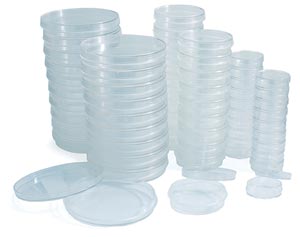 If you want to have accurate bacterial data, yes, your petri dishes need to be sterile. Each year, I open a new sleeve of plastic petri dishes so I’m certain they are sterile. Educational Innovations sells large, small and mini plastic Petri Dishes—all sterile and ready for use. If you don’t have access to new ones, you can re-use petri dishes, but make sure to either sterilize them in an autoclave or clean them thoroughly in a bleach solution followed by a distilled water rinse.
If you want to have accurate bacterial data, yes, your petri dishes need to be sterile. Each year, I open a new sleeve of plastic petri dishes so I’m certain they are sterile. Educational Innovations sells large, small and mini plastic Petri Dishes—all sterile and ready for use. If you don’t have access to new ones, you can re-use petri dishes, but make sure to either sterilize them in an autoclave or clean them thoroughly in a bleach solution followed by a distilled water rinse.
HOW DO I MAKE AGAR PLATES?
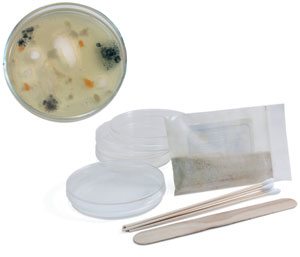 The Bacteria Growing Kit from Educational Innovations will come with clear directions, but methods will vary slightly depending on the agar you purchase. Here is the general process:
The Bacteria Growing Kit from Educational Innovations will come with clear directions, but methods will vary slightly depending on the agar you purchase. Here is the general process:
1. Measure out the desired amount of nutrient agar and distilled water and pour into a clean beaker. Some recipes call for 23g of dehydrated agar per liter of distilled water. For the kit from Educational Innovations, please consult the print instructions. (General note: one liter of agar will fill roughly 30 to 40 petri dishes).
2. Add a stir magnet to the beaker and place on your hot plate. Turn on both the heat and the stir settings.
3. Continue to heat and stir your agar until it is boiling. This may take a while, but be patient! If you don’t wait for it to boil, your agar won’t solidify once it cools.
4. ALTERNATE: If you don’t have access to a hot plate, you can use a microwave oven. Place the beaker and agar mixture into the microwave and heat for three minutes. Continue heating in one-minute bursts until the agar is completely dissolved and the mixture begins to boil.
5. As you are waiting for the agar to boil, lay out your sterile petri dishes on a heat-resistant surface. Keep the lids on to avoid any bacterial contamination.
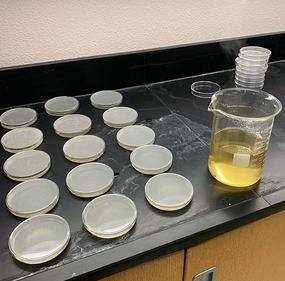
6. Once the agar has come to a boil, remove the beaker from the heat. Remember to use heat-resistant gloves. Lift the lid on the first petri dish, then carefully pour some agar until the dish is roughly 2/3 full, and promptly return the lid. Continue until all your agar has been used.
7. Allow the agar to solidify at room temperature. This shouldn’t take more than 15 minutes.
8. Once the agar has solidified and cooled, store your petri dishes upside down in the fridge until you are ready to use them. Storing them upside down will ensure that any condensation drips onto the lid, not onto your agar.
HOW MANY DAYS BEFORE USE CAN I POUR THE PLATES?
I typically pour the petri dishes a day or two before I need them. Petri dishes in the fridge will be good for a few weeks before they begin to dry out. The sooner you use them, the better.
I HAVE 150 STUDENTS. HOW MANY PLATES WILL I NEED TO PREPARE?
It can be costly to pour a ton of plates every year. With 150 students, it would be way too expensive (and a lot of work!) to pour a plate for each student.
I put my students in groups of four when we do this lab. With roughly 32 students per class, this means I’m pouring eight plates per class.
I let each group choose a variable to test. They document their experimental design on the whiteboard. A popular idea is to determine the validity of the “three second rule” about food dropped on the floor. Some groups want to change the amount of time the food is on the floor. Other groups want to test different food types or try out different dirty surfaces. Once I’ve approved their design (to make sure they have a control), they can begin their lab.
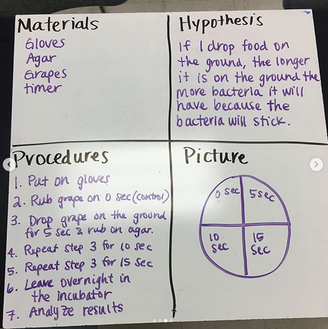
DO I NEED AN INCUBATOR?
If you want quick, overnight results, then an incubator will speed up the bacterial growth process. But if you don’t have access to one, just let the plates sit for an extra day or two in your classroom. You’ll still get plenty of bacterial growth. I recommend doing this lab with your students on a Friday. When you come back to school on Monday, you should be ready to collect data. Again, leave the petri dishes upside down (agar side up) so you don’t have issues with condensation dripping onto your agar.
HOW DO STUDENTS COLLECT BACTERIAL DATA?
Since I do this lab during the first week of school, this is an excellent time to review the difference between quantitative and qualitative data. Once students get their petri dishes back, I have them make both qualitative observations and measure quantitative data.
You can have students collect quantitative data by counting colonies, but a much easier way is to use a grid and calculate percent coverage. You can purchase gridded stickers that stick onto your petri dish lids, or just do it yourself with a fine-point permanent marker. Students can count the number of squares that show bacterial growth, divide that number by the total number of squares, and then multiply it by 100 to turn it into a percentage.
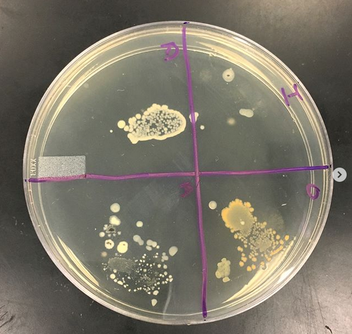
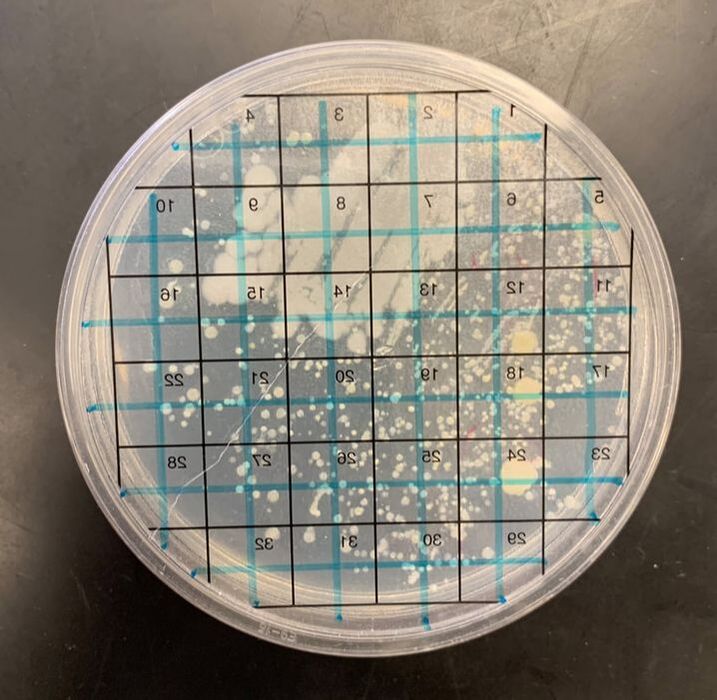
HOW DO I DISPOSE OF THE PLATES?
It is important you do not place your plates in the trash without first taking some precautions. While bacteria in small numbers may be harmless, once cultured into millions of cells, they can pose a greater threat. There are a few ways to properly dispose of your used agar plates, depending on what you have available:
1. If you have an autoclave, you can autoclave your plates per the directions on your autoclave (generally at least 30 minutes).
2. If you used glass petri dishes and don’t have an autoclave, prepare a 20% bleach solution and spray your plates down. Allow the bleach to soak into the agar for one hour before placing agar in the trash. Then thoroughly clean your empty petri dishes again with a bleach solution and distilled water rinse.
3. If you used plastic petri dishes that you can afford to part with, you can place them in bio-hazard bags and have your school district arrange for bio-hazard pick up. It doesn’t hurt to spray them down with a 20% bleach solution before placing them in bio-hazard bags.
ADDITIONAL SAFETY NOTES:
1. When students complete the lab, it is best to have them wear gloves and goggles.
2. Always have students wash their hands and wipe down tables after the lab.
3. Make sure your glassware is not chipped before heating. If you have any cracks in your beaker, it can shatter on your hot plate. (Trust me, I learned this the hard way.)
4. Be sure to keep an SDS of all chemicals on file.
I hope you and your students have a blast with this bacterial culture lab. I know mine always do!
About the Author: Becca Fanucci is an Arizona educator who has been teaching science to students in grades 6-12 for more than a decade. Her website with lessons can be found here: www.sciencelessonsthatrock.com.


This entry was posted on Friday, November 8th, 2019 at 2:25 am and is filed under Biology, High School level, Middle School level. You can follow any responses to this entry through the RSS 2.0 feed. You can leave a response, or trackback from your own site.